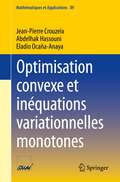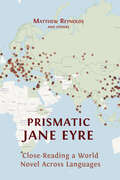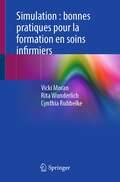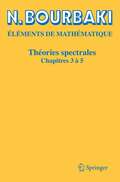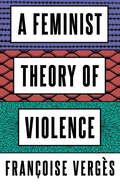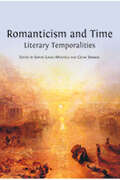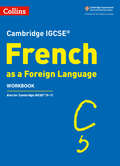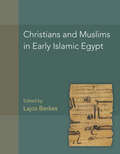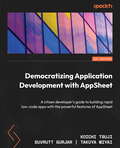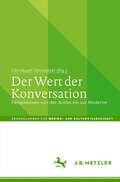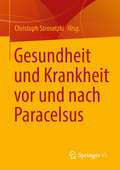- Table View
- List View
Œuvres complètes de Voltaire: Corpus des notes marginales de Voltaire 3: Dale-Frisi (Œuvres complètes de Voltaire (Complete Works of Voltaire) #138)
by VoltairePart of the complete works of the French philosopher, historian and social reformer, Voltaire. One in a 13-volume set which reprints Voltaire's marginal notes in the alphabetical sequence of the books in his library. An indispensable scholarly tool for students and scholars of the 18th-century Enlightenment with research interests in Voltaire.
Œuvres complètes de Voltaire: Tables (Œuvres complètes de Voltaire (Complete Works of Voltaire) #148)
Part of the complete works of the French philosopher, historian and social reformer, Voltaire. Contains a complete index of titles of Voltaire's works, a list of verse incipits, and a full chronological list of each volume. An indispensable key to the full 205-volume set. For students and scholars of the 18th-century Enlightenment.
Œuvres complètes de Voltaire: Oeuvres de 1772 (I) (Œuvres complètes de Voltaire (Complete Works of Voltaire) #74A)
by VoltairePart of the complete works of the French philosopher, historian and social reformer, Voltaire. Contains his last philosophical story, "Le Taureau blanc", and other works designed to shape his image after his death. For students and scholars of the 18th-century Enlightenment.
Œuvres complètes de Voltaire: Oeuvres de 1773 (Œuvres complètes de Voltaire (Complete Works of Voltaire) #75A)
by VoltairePart of the complete works of the French philosopher, historian and social reformer, Voltaire. Contains Voltaires's defence of the Comte de Morangies, as well as campaigning works opposing the enemies of the philosophes. For students and scholars of the 18th-century Enlightenment.
Œuvres complètes de Voltaire: Fragments sur l'Inde; Mandement du muphti (Œuvres complètes de Voltaire (Complete Works of Voltaire) #75B)
by VoltairePart of the complete works of the French philosopher, historian and social reformer, Voltaire. Contains the first ever critical edition of a neglected text on Indian history, religion and customs from his later years. For students and scholars of the 18th-century Enlightenment.
Œuvres complètes de Voltaire: Collection des lettres sur les miracles. Ecrites a Geneve, et a Neufchatel (Œuvres complètes de Voltaire (Complete Works of Voltaire) #60D)
by VoltairePart of the complete works of the French philosopher, historian and social reformer, Voltaire. In 1766 Voltaire throws himself into disagreements with Genevan personalities (David Claparede, Jean-Jacques Rousseau) and engages with political controversies in the city. For students and scholars of the 18th-century Enlightenment.
Œuvres complètes de Voltaire: Miscellaneous verse (Œuvres complètes de Voltaire (Complete Works of Voltaire) #83)
by VoltairePart of the complete works of the French philosopher, historian and social reformer, Voltaire. Contains poetry for which the year of composition is unknown, all being short pieces. For students and scholars of the 18th-century Enlightenment.
Œuvres complètes de Voltaire: Commentaire historique sur les oeuvres de l'auteur de La Henriade, etc. Avec les pieces originales et les preuves, I: Introduction et dossier (Œuvres complètes de Voltaire (Complete Works of Voltaire) #78B)
by VoltaireSold as a multi-volume set – the individual volumes are also available for purchase. Part of the complete works of the French philosopher, historian and social reformer, Voltaire. Contains his last memoirs and a selection of his letters. For students and scholars of the 18th-century Enlightenment.
Œuvres complètes de Voltaire: Traite sur la tolerance (Œuvres complètes de Voltaire (Complete Works of Voltaire) #56C)
by VoltaireContains Voltaire's monumental 'Traite sur la tolerance', a manifesto on religious fanaticism and superstition which calls for a new age of tolerance between religions following the injustice of the death of Jean Calas, executed for murder in Toulouse, who Voltaire believed to be an innocent victim of anti-protestant prejudice. For students and scholars of the 18th-century Enlightenment.
Optimisation convexe et inéquations variationnelles monotones (Mathématiques et Applications #89)
by Jean-Pierre Crouzeix Abdelhak Hassouni Eladio Ocaña-AnayaDe nombreux systèmes physiques, mécaniques, financiers et économiques peuvent être décrits par des modèles mathématiques qui visent à optimiser des fonctions, trouver des équilibres et effectuer des arbitrages. Souvent, la convexité des ensembles et des fonctions ainsi que les conditions de monotonie sur les systèmes d'inéquations qui régissent ces systèmes se présentent naturellement dans les modèles. C'est dans cet esprit que nous avons conçu ce livre en mettant l'accent sur une approche géométrique qui privilégie l'intuition par rapport à une approche plus analytique. Les démonstrations des résultats classiques ont été revues dans cette optique et simplifiées. De nombreux exemples d'applications sont étudiés et des exercices sont proposés.Ce livre s'adresse aux étudiants en master de mathématiques appliquées, ainsi qu'aux doctorants, chercheurs et ingénieurs souhaitant comprendre les fondements de l'analyse convexe et de la théorie des inéquations variationnelles monotones.
Prismatic Jane Eyre: Close-Reading a World Novel Across Languages
by Matthew Reynolds OthersJane Eyre, written by Charlotte Brontë and first published in 1847, has been translated more than five hundred times into over sixty languages. Prismatic Jane Eyre argues that we should see these many re-writings, not as simple replications of the novel, but as a release of its multiple interpretative possibilities: in other words, as a prism. Prismatic Jane Eyre develops the theoretical ramifications of this idea, and reads Brontë’s novel in the light of them: together, the English text and the many translations form one vast entity, a multilingual world-work, spanning many times and places, from Cuba in 1850 to 21st-century China; from Calcutta to Bologna, Argentina to Iran. Co-written by many scholars, Prismatic Jane Eyre traces the receptions of the novel across cultures, showing why, when and where it has been translated (and no less significantly, not translated – as in Swahili), and exploring its global publishing history with digital maps and carousels of cover images. Above all, the co-authors read the translations and the English text closely, and together, showing in detail how the novel’s feminist power, its political complexities and its romantic appeal play out differently in different contexts and in the varied styles and idioms of individual translators. Tracking key words such as ‘passion’ and ‘plain’ across many languages via interactive visualisations and comparative analysis, Prismatic Jane Eyre opens a wholly new perspective on Brontë’s novel, and provides a model for the collaborative close-reading of world literature. Prismatic Jane Eyre is a major intervention in translation and reception studies and world and comparative literature. It will also interest scholars of English literature, and readers of the Brontës.
Prismatic Jane Eyre: Close-Reading a World Novel Across Languages
by Matthew Reynolds OthersJane Eyre, written by Charlotte Brontë and first published in 1847, has been translated more than five hundred times into over sixty languages. Prismatic Jane Eyre argues that we should see these many re-writings, not as simple replications of the novel, but as a release of its multiple interpretative possibilities: in other words, as a prism. Prismatic Jane Eyre develops the theoretical ramifications of this idea, and reads Brontë’s novel in the light of them: together, the English text and the many translations form one vast entity, a multilingual world-work, spanning many times and places, from Cuba in 1850 to 21st-century China; from Calcutta to Bologna, Argentina to Iran. Co-written by many scholars, Prismatic Jane Eyre traces the receptions of the novel across cultures, showing why, when and where it has been translated (and no less significantly, not translated – as in Swahili), and exploring its global publishing history with digital maps and carousels of cover images. Above all, the co-authors read the translations and the English text closely, and together, showing in detail how the novel’s feminist power, its political complexities and its romantic appeal play out differently in different contexts and in the varied styles and idioms of individual translators. Tracking key words such as ‘passion’ and ‘plain’ across many languages via interactive visualisations and comparative analysis, Prismatic Jane Eyre opens a wholly new perspective on Brontë’s novel, and provides a model for the collaborative close-reading of world literature. Prismatic Jane Eyre is a major intervention in translation and reception studies and world and comparative literature. It will also interest scholars of English literature, and readers of the Brontës.
Simulation : bonnes pratiques pour la formation en soins infirmiers
by Vicki Moran Rita Wunderlich Cynthia RubbelkeCe livre présente les normes fondées sur les preuves pour l’enseignement de la simulation en soins infirmiers. Le principe fondamental de l'excellence et de la pertinence de la simulation en soins infirmiers est détaillé tout au long de l'ouvrage. Il aborde également les éléments nécessaires à une simulation de qualité, de son développement à sa mise en œuvre. Ces domaines (non exhaustifs) incluent le contexte théorique, l'accréditation et normes d'homologation, l'environnement, le développement et la mise en œuvre de différents types de simulations et enfin le débriefing. Ces domaines sont décrits sur la base d’un examen approfondi de la littérature et des pratiques actuelles proposées par l'International Nursing Association for Clinical Simulation and Learning (INACSL), la Society for Simulation in Healthcare (SSH), la National League for Nursing (NLN) et les State Boards of Nursing (USA). Cet ouvrage deviendra rapidement un guide de référence pour de meilleures pratiques de la simulation dans l'enseignement des soins infirmiers.
Théories spectrales: Chapitres 3 à 5
by N. BourbakiLes Éléments de mathématique de Nicolas Bourbaki ont pour objet une présentation rigoureuse, systématique et sans prérequis des mathématiques depuis leurs fondements.Ce second volume, inédit, du Livre consacré aux Théories spectrales a pour thème les propriétés spectrales des applications linéaires.Le chapitre 3 étudie les applications linéaires compactes entre espaces vectoriels topologiques et la théorie de la perturbation par addition d'une application linéaire compacte, en particulier la théorie de Fredholm. Il se poursuit par la description du spectre d'un endomorphisme compact d'un espace de Banach, notamment les notions de spectre sensible et de spectre essentiel. On y démontre le théorème de Krein--Rutman.Le chapitre 4 contient les résultats fondamentaux de la théorie spectrale hilbertienne : opérateurs compacts et nucléaires, endomorphismes normaux, opérateurs partiels normaux. On y trouve également un exposé concis des distributions et distributions tempérées.Enfin, le chapitre 5 aborde l'étude des représentations unitaires des groupes topologiques (constructions élémentaires, lemme de Schur, représentations de carré intégrable modulo le centre, classes de représentations irréductibles). On y développe aussi la théorie des fonctions de type positif et on y démontre le théorème fondamental de Peter--Weyl.Le texte est complété par de nombreux exercices et par une note historique portant sur le contenu des chapitres 1 à 5.
Without Trace: An Utterly Gripping Detective Crime Thriller With An Unexpected Twist (Di Geraldine Steel Ser. #20)
by Leigh RussellA Feminist Theory of Violence: A Decolonial Perspective
by Françoise Vergès'A robust, decolonial challenge to carceral feminism' - Angela Y. Davis ***Winner of an English PEN Award 2022*** The mainstream conversation surrounding gender equality is a repertoire of violence: harassment, rape, abuse, femicide. These words suggest a cruel reality. But they also hide another reality: that of gendered violence committed with the complicity of the State. In this book, Françoise Vergès denounces the carceral turn in the fight against sexism. By focusing on 'violent men', we fail to question the sources of their violence. There is no doubt as to the underlying causes: racial capitalism, ultra-conservative populism, the crushing of the Global South by wars and imperialist looting, the exile of millions and the proliferation of prisons – these all put masculinity in the service of a policy of death. Against the spirit of the times, Françoise Vergès refuses the punitive obsession of the State in favour of restorative justice.
An Outline of Romanticism in the West
by John Claiborne IsbellNavigating the landscape of Romantic literature and art across Europe and the Americas, An Outline of Romanticism in the West invites readers to embark upon a literary journey.
An Outline of Romanticism in the West
by John Claiborne IsbellNavigating the landscape of Romantic literature and art across Europe and the Americas, An Outline of Romanticism in the West invites readers to embark upon a literary journey.
An Outline of Romanticism in the West
by John Claiborne IsbellNavigating the landscape of Romantic literature and art across Europe and the Americas, An Outline of Romanticism in the West invites readers to embark upon a literary journey.
Cambridge IGCSE™ French Workbook: Course Licence (Collins Cambridge IGCSE™)
by Oliver GrayCollins IGCSE® French Workbook supports the Student’s Book by providing additional material for skills development and language practice.
Christians and Muslims in Early Islamic Egypt (American Studies in Papyrology #56)
by Lajos BerkesThis volume collects studies exploring the relationship of Christians and Muslims in everyday life in Early Islamic Egypt (642–10th c.) focusing mainly, but not exclusively on administrative and social history. The contributions concentrate on the papyrological documentation preserved in Greek, Coptic, and Arabic. By doing so, this book transcends traditional disciplinary boundaries and offers results based on a holistic view of the documentary material. The articles of this volume discuss various aspects of change and continuity from Byzantine to Islamic Egypt and offer also the (re)edition of 23 papyrus documents in Greek, Coptic, and Arabic. The authors provide a showcase of recent papyrological research on this under-studied, but dynamically evolving field. After an introduction by the editor of the volume that outlines the most important trends and developments of the period, the first two essays shed light on Egypt as part of the Caliphate. The following six articles, the bulk of the volume, deal with the interaction and involvement of the Egyptian population with the new Muslim administrative apparatus. The last three studies of the volume focus on naming practices and language change.
Complete Works of Voltaire 26C: Essai sur les moeurs et l'esprit des nations (VIII): Chapitres 177-197 (Œuvres complètes de Voltaire (Complete Works of Voltaire) #26C)
by VoltairePart of the complete works of the French philosopher, historian and social reformer, Voltaire. Contains chapters 177-197 of his world history. For students and scholars of the 18th-century Enlightenment.
Democratizing Application Development with AppSheet: A Citizen Developer's Guide To Building Rapid Low-code Apps With The Powerful Features Of Appsheet
by Koichi Tsuji, Suvrutt Gurjar, and Takuya MiyaiA citizen developer's guide to building rapid low-code apps with the powerful features of AppSheet
Der Wert der Konversation: Perspektiven von der Antike bis zur Moderne (Abhandlungen zur Medien- und Kulturwissenschaft)
by Christoph StrosetzkiWoran wird der Wert der Konversation gemessen? Gibt es wertvollere und minderwertige Typen der Konversation? Welche Rolle kommt den Inhalten, den Personen und den Umständen zu? Prägen Zeiten und Epochen die je ihnen eigenen Konversationen? Konversationsnormen aus Handbüchern ebenso wie in Texten wiedergegebene oder aus Texten rekonstruierte Konversationen geben Aufschluss über diese Fragen. Die Beiträge im vorliegenden Band gruppieren sich um begriffliche Fragen, bestimmte Kontexte wie den Salon und das Tischgespräch, bringen Studien zu einzelnen literarischen Texten und decken dabei die europäische Kulturgeschichte von Platon bis ins 20. Jahrhundert ab.
Gesundheit und Krankheit vor und nach Paracelsus
by Christoph StrosetzkiBedeutend ist Theophrast von Hohenheim (ca. 1493/4–1541), genannt Paracelsus, vor allem durch sein Aufbegehren gegen die klassischen antiken und arabisch-mittelalterlichen Autoritäten in der Medizin. Grundlage sollen nicht mehr die überlieferten Schriften, sondern experientia, experimenta und ratio sein. Von dieser Basis soll künftig ausgegangen werden, was Paracelsus auch dadurch unterstreicht, dass er seine Schriften in deutscher Sprache veröffentlicht. Indem er sich gegen die dogmatische Auslegung antiker Texte wandte, wollte er die Ära Galens beenden. Die Chirurgie wollte er auf universitären Rang erheben. Nach Paracelsus ist es die Natur, die heilt, wobei der Arzt nur Helfer ist. Wenn er Gesundheit als harmonische Ordnung im organischen Ablauf definiert, dann ist er bestrebt, Makrokosmos und Mikrokosmos, Diesseits und Jenseits, in Einklang zu bringen. Die Welt ist für ihn kein Nebeneinander isolierter Elemente, sondern eine Einheit. Auch beim Menschen erscheint ihm Sinnliches und Seelisches aufeinander bezogen. Archeus nennt er ein immaterielles Prinzip, in dem er den Träger der belebenden Kraft in der Natur und im Menschen, also im Makrokosmos wie im Mikrokosmos, festmacht. Im Sinne der Renaissance sieht er den Menschen als Mittelpunkt des Kosmos und seine Aufgabe im Erkennen der Welt.

